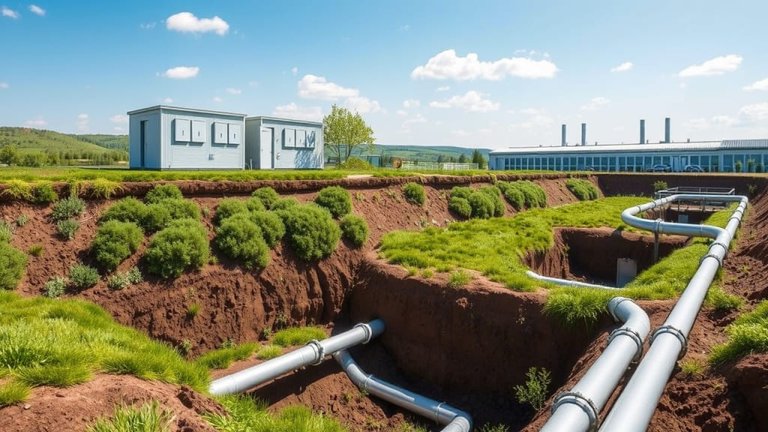
Geothermal energy, often referred to as the hidden power beneath our feet, is a vast, untapped resource capable of revolutionizing the way we think about sustainable energy. As the world faces increasing challenges related to climate change, energy security, and sustainable development, geothermal energy emerges as a beacon of hope, offering a consistent, reliable, and environmentally friendly solution.
Understanding Geothermal Energy
Geothermal energy is derived from the natural heat stored beneath the Earth's surface. This heat originates from the Earth's core, where temperatures reach up to 6,000°C (10,800°F), and it radiates outward through layers of rock and water reservoirs. The energy can be captured in various ways:
Direct Use Applications: Heating buildings, greenhouses, and aquaculture ponds.
Geothermal Heat Pumps: Efficiently heating and cooling homes and businesses.
Electricity Generation: Using steam or hot water to drive turbines connected to electricity generators.
Why Geothermal Energy Matters
Geothermal energy offers numerous advantages over other renewable sources:
1. Consistency and Reliability: Unlike solar and wind, geothermal power is not weather-dependent, providing a constant energy supply 24/7.
2. Low Environmental Impact: It produces minimal greenhouse gases compared to fossil fuels.
3. Sustainable and Long-Lasting: With proper management, geothermal reservoirs can provide energy for decades without depletion.
4. Small Land Footprint: Geothermal plants require less land compared to solar farms or wind parks.
Challenges and Opportunities in Geothermal Energy
While geothermal energy has immense potential, it faces certain challenges:
High Initial Costs: Drilling and exploration require significant upfront investments.
Geographic Limitations: Optimal geothermal sites are often located in volcanic or tectonically active regions.
Technological Barriers: Advanced drilling techniques and resource management strategies are needed to improve efficiency.
However, these challenges present opportunities for innovation and growth:
Enhanced Geothermal Systems (EGS): Technologies that enable geothermal energy extraction in non-traditional areas.
Deep Drilling Techniques: Reaching greater depths to access higher temperature resources.
Closed-Loop Systems: Improving efficiency and reducing environmental impacts.
Geothermal Energy Around the World
Globally, countries are increasingly recognizing the value of geothermal energy:
Iceland: Nearly 90% of homes are heated with geothermal energy.
Kenya: A leader in geothermal development in Africa, contributing significantly to its national grid.
United States: The largest producer of geothermal electricity globally, particularly in California and Nevada.
Emerging markets also show great promise, with developing nations investing in geothermal to achieve energy independence and sustainability.
Economic Benefits of Geothermal Energy
Investing in geothermal energy drives significant economic advantages:
Job Creation: Opportunities in drilling, engineering, plant operations, and maintenance.
Local Economic Growth: Reducing energy import dependence and fostering domestic industries.
Cost Efficiency: Once established, geothermal plants offer low operating costs and stable energy prices.
Environmental Impact and Climate Benefits
Geothermal energy is a powerful tool in the fight against climate change:
Reduction of Greenhouse Gases: Minimal emissions compared to fossil fuels.
Land Preservation: Smaller land use footprint than wind and solar installations.
Water Conservation: Advanced technologies reduce water usage and contamination risks.
The Future of Geothermal Energy
The global shift towards renewable energy is inevitable, and geothermal energy is poised to play a critical role in this transition. As emerging technologies make it feasible to tap into deeper and more diverse geothermal resources, the potential for widespread adoption grows exponentially.
Expanding Access: From developed cities to remote communities, geothermal energy can provide reliable, clean power.
Economic Growth: Creating jobs in drilling, plant operations, and technology development.
Environmental Benefits: Reducing carbon footprints and combating climate change.
Conclusion
The hidden power beneath our feet holds the key to a sustainable future. By harnessing geothermal energy, we can unlock a cleaner, greener, and more resilient world. The time to invest in geothermal technologies and support innovative solutions is now—ensuring energy security and environmental sustainability for generations to come.
As we move forward, embracing geothermal energy isn’t just an option; it’s a necessity for a sustainable planet. Its untapped potential promises to be a cornerstone of our global energy strategy, fostering economic resilience, environmental stewardship, and a future powered by the Earth's own natural heat.